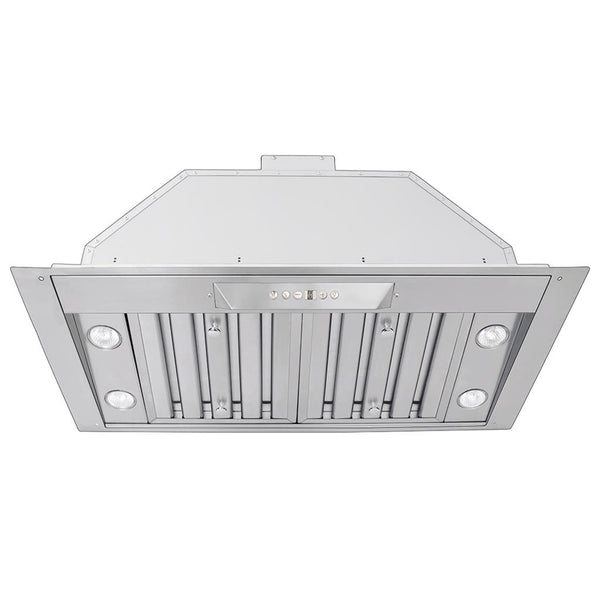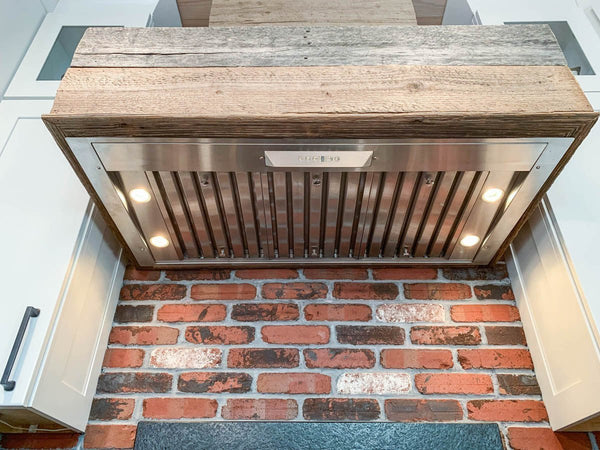Table of Contents
Proline Range Hood Blower Options
At Proline Range Hoods, all of our range hoods come with a pre-installed and factory-tested local blower, excluding our fully customizable ProV models. With these range hoods, you have the option to choose between up to three different types of blowers:
- 1200 CFM VexAir Local Blower
- 1700 CFM VexAir Local Blower
- 1300 CFM VexAir Inline Blower
If you purchase the inline blower option for your new range hood, you'll have to either install it yourself or hire a contractor. We want to make the range hood installation process easier for whoever is installing your vent hood blower, which is why we've provided this step-by-step guide on how to install our VexAir inline blower.
Note that the larger your ductwork, the more efficient the blower in your hood vent will be able to filter unwanted cooking odors and contaminants out of your home. Larger ductwork allows for more cubic feet of air to be pushed through your vents, improving air quality in your cooking area quickly and efficiently. This is especially important for home chefs who frequently use their cooktop for high-heat cooking.
Depending on the CFM, some ducted range hoods may require a minimum diameter for your ductwork; just make sure you are aware of this before you proceed with the installation. Unlike a ductless range hood, inline blowers require proper venting through an exterior wall or roof with a vent cap. If you would like more information on making sure you have the right size ductwork for your kitchen hood, check out the article we wrote here.

How to Install a VexAir Inline Blower
For the purposes of this article, we'll be installing a 1100 CFM VexAir Inline Blower and running 10-inch ductwork. This home improvement project is perfect for DIYers looking to complete their new hood installation.
What's in the Box
Our range hood blowers don't just come by themselves. We provide a few necessary parts to help you complete your installation:
- 1100 CFM VexAir Inline Blower
- Hardware Bag (includes four screws, four nuts, and four bolts)
Note: You won't need to assemble and attach a mounting bracket; it will already be attached to the blower out of the box.
Other Supplies or Tools You'll Need
- Drill or screwdriver
- Four grabber screws
- 12 self-tapping screws (these will go through metal)
- Aluminum foil duct tape
- Transition pieces - for this installation, you'll need two 12-inch to 10-inch transitions
Step-by-Step Installation Guide
Step 1 - Find a Place for Your Blower
There are three things to consider when deciding where to place your inline blower during your range hood install.
First, there has to be enough space for your blower to fit inside your wall or in your attic. Second, your ductwork has to be strong enough to support the weight of the hood blower assembly. Third, depending on the weight of the blower, you'll likely want to screw it into a nearby wall to ensure that your ductwork doesn't collapse. Use rigid single-wall ductwork (not flexible ducting) for maximum support. The blower should be positioned between your cooking surface hood and the vent hole in your exterior wall or roof, where the wall cap will be installed.
Step 2 - Build the Mounting Bracket and Attach It to the Blower
This step, as shown in the video, is no longer necessary. We now simply attach the brackets before shipping; for your convenience, they are already attached to the blower when you receive them. This follows the manufacturer's instructions for optimal installation. Proceed to Step 3.
Step 3 - Mount the Blower to Your Wall or Ceiling
The most important thing to consider when mounting your blower is which direction it will face. The blowers have a sticker that has an arrow, pointing in the direction the air will flow. When mounted, the direction of your arrow should point toward the outside wall – where you want the air to go – and not back toward your stainless steel range hood unit above your cooktop.
If possible, find studs to mount the blower; they are the most reliable support system, similar to mounting a cabinet bottom or other heavy fixtures. To mount the blower, lift it up against the wall or support and then screw the blower into the wall using the four grabber screws provided. Make sure the mounting is secure enough to handle the weight of the hood blower.
If you need a drill or screwdriver, check out these reliable products from Amazon below:
Step 4 - Attach Transition Pieces (if necessary)
Depending on the size of your ductwork and the size of your blower, you may need transition pieces. Some installations may require a rectangular vent adapter if transitioning from round to rectangular ductwork. For this installation, our blower is 12 inches in diameter, and the ductwork is 10 inches in diameter, so we'll use two 10 to 12-inch transition pieces.
First, line up the transition piece with your blower. Next, screw three of your self-tapping screws into the top, bottom, and side of each transition piece. Make sure there's adequate clearance around the ductwork, similar to maintaining a proper distance from a water supply line or other utilities.
After the transition piece is screwed into the blower, wrap your aluminum foil duct tape a couple of times around the transition piece to secure it in place and make the ductwork airtight. This prevents air leakage and ensures your exhaust fans work at peak efficiency.
Step 5 - Attach Transitions to Your Ductwork
In this step, you'll essentially repeat step 4, except this time you'll attach the transition pieces to your ductwork running to your vent cap on the exterior wall.
Align the transition pieces with your ductwork and use three self-tapping screws on each side to fasten the blower in place. As in step four, seal the ductwork with aluminum foil tape to make it airtight. This is crucial for maintaining proper airflow from your cooking area through the entire ventilation system.
Click here to see how your ductwork should look at this point in the installation process.
Step 6 - Run Power to the Blower
Since this blower will be within your ductwork, you likely won't have an outlet in your attic. So, use an extension cord and run it to your nearest outlet to power your blower. Unlike range microwaves that plug into standard outlets, inline blowers may require dedicated electrical connections.
If an extension cord is not enough, consult an electrician to ensure that you complete this step properly. Depending on where you live, you'll have different electrical codes for how and where you can run power. A licensed electrician can install a proper junction box with the electrical cable and ground wire needed for a permanent installation. They'll ensure the power cable meets local building codes and is properly secured. Never attempt to make electrical connections without proper knowledge, and always follow the manufacturer's instructions regarding electrical requirements.
Note: This electrical work is separate from the electrical connections at the top of the hood where your stainless steel range hood control panel connects. The inline blower requires its own power source.
Final Checks and Powering Up
Once you've hooked up your power, you're good to go. Go turn it on and make sure it works the way you expect it to. Test it at various speeds to ensure proper air movement from your cooking surface through the ductwork and out the vent hole. Check that there are no air leaks at any connection points and that the vent cap on your outside wall is opening properly. If for any reason it doesn't work as expected, give us a call at (801) 973-3959. This is how it should look when its all said and done:

Hopefully, this guide on installing your VexAir inline blower has saved you some valuable time and effort with your range hood installation project. Whether you're upgrading from a ductless range hood or installing a new range hood system in your kitchen, proper installation ensures optimal performance. This step-by-step guide should help both DIY enthusiasts and professional installers complete the job correctly.
If you have found any of our blog content helpful in any way, please leave us a review on Yelp or Google. It only takes 10 seconds!
Need more guidance? Watch our VexAir Inline Blower installation video.
Related Posts
Looking for more information on range hood installation and kitchen ventilation? Check out our related posts on choosing the 10 best range hoods for your cooking needs, comparing ducted range hoods versus ductless options, and tips for maintaining optimal air quality in your cooking area.












